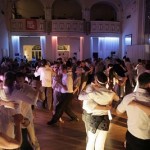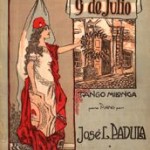Just another song I heard in a shopping centre, which I thought to be tangoable. The life version is accompanied by world class bandoneon player Karel Kraayenhof

22/07/2014
by Richard Stoll
0 comments


22/07/2014
by Richard Stoll
0 comments
Just another song I heard in a shopping centre, which I thought to be tangoable. The life version is accompanied by world class bandoneon player Karel Kraayenhof

22/07/2014
by Richard Stoll
0 comments
Tango is mainly a social dance (apart from Tango show-dancing, which is NOT the subject here) and having completed a beginners course, we want to dance and enjoy the marvelous music and the atmosphere of Milongas. So why progress ? actually Tango is not a highly structured ballroom dance, Tango movements are almost completely improvised and thus communication is the name of the game. If communication does not happen, that makes things difficult and the amount of fun limited. You will feel that during the dance and also when you count the numbers of dances during a Milonga. Beginners usually have problems to find a dance partner (leaders may notice that lots of cabeceos are ignored and followers will sit more than dance). Of course tangueros are polite (if they aren´t they are no real tangueros), but this is a well-known problem. Please do not confuse that with physical attractiveness. Of course it helps a lot looking like a supermodel, but most of the real tangueros would always prefer a better dancer (even if the partner doesn’t look like a supermodel). So for advanced dancers, skilled in tango communication it is definitively easier to find a dance partner. For a typical beginner after completing a first beginner’s course, what can be done to improve? Here are some simple hints for you:
Continue Reading →

20/07/2014
by Richard Stoll
0 comments
OK, I am back from Europe and some month of other commitments.
The orchestra I want to present today is not from Argentina, but from Italy. I have picked this one, because they are really present in European Tango festivals. Actually, I was interested in orchestras performing “Cafe Dominguez”, a quite rare song (see my article about Sexteto Milonguero).
Ensemble Hyperion is an Italian group, formed in 1992, which has published 7 CDs so far. The latest CD (“Epoca de Oro”) was published in 2011. The range of songs is broad from traditional Tangos to Piazzolla music.
Continue Reading →
29/05/2014
by Richard Stoll
0 comments
I have seen Tango communities break apart because of that stupid question and this problem seems to be a constant one all over the world. Really ? Not in Argentina. Somehow at least this problem seems not to be recognized there. It seems that lots of the modern teachers are members of the “one tango” fraction. Interestingly, the question has also been researched in a PhD thesis written by Carolyn Merritt:
http://digital.library.temple.edu/cdm/ref/collection/p245801coll10/id/13758
A good and short summary with lots of quotes from the Argentineans who designed modern tango can be found here:
What can we learn from this ? The educated and open minded tanguero should know that the so called Nuevo is just a description for new elements introduced into tango since around 1995. This is not a new style of dancing. The hold just has to be adjusted to the condition of the dancefloor and the energy of the movements. So seeing a traditional flavoured couple dancing in open embrace is not uncommon and also masters associated with “nuevo” can be seen dancing in a close embrace. This is the quintessence of an enrichment and it should not be misused as a reason for restriction.
Saludos,
-Richard

09/03/2014
by Richard Stoll
0 comments
OK, I have worked through the stack of new CDs from Buenos Aires, so today I have to talk about something else. Fortunately, I had a discussion with a fellow tanguero from Germany last week and he asked me to listen to a song from Sexteto Milonguero, which directly inspired me to this post. Without a CD, I have completely to rely on Internet footage, which fortunately is no problem for this orchestra.
Many people say, it is difficult to dance to contemporary orchestras, because they do not focus on the needs of dancers. Apart from some notorious Piazzolla sound-alikes, I do not agree. Sexteto Milonguero actually plays for dancers which makes their music very interesting. Continue Reading →

08/03/2014
by Richard Stoll
0 comments
La Cumparsita
No other tango in History has led to so much confusion and arguments. Everybody loves it, almost every Tango orchestra has played a version and it is played almost at all Milongas who stick to the traditional Argentinean codices. Again this little song started not as a Tango.

07/03/2014
by Richard Stoll
0 comments
I am sitting at my computer desk and trying to write a new article. To my right side there is the stack of some new CDs from last year´s trip to Buenos Aires. New CDs are normally grabbed directly into my computer database which takes less than 10 min. per CD (included tagging) then they go into a storage box. There are not many CDs left to discuss and I admit that I mainly bought modern electronic Tango, because my collection is weak in that regard. So there are only two CD left for discussion. One is a collection of Julio de Caro (which is of course not electronic music but was also needed to complete my collection). Today we look at the 2012 CD “Incidental Tango” of Tanghetto.

07/03/2014
by Richard Stoll
0 comments
OK, as a DJ I have to buy Tango CDs and being in Buenos Aires usually is a good opportunity to do so. One of the CDs I have brought with me last time was “Tango 3.0” from Gotan Project.
You do not know Gotan Project ? You are either no Tanguero or really focused on traditional Tango. Continue Reading →

25/01/2014
by Richard Stoll
0 comments
People have told me that in this blog I put too much weight on modern and NeoTango music. I agree, I confess and I regret. Actually I would like to start a new series of articles with more traditional focus, but I again want to concentrate on musical themes and some basic knowledge for educated tangueros/tangueras.
So there are some typical tangos, everybody knows and most of us can identify and name with the original title in Spanish. Usually, they (let us call them “big tangos”) have been played by different orchestras and they have an established position in international Tango folklore.
For some of them a story can and will be told. Some have very special lyrics, some of them don´t have lyrics at all. Some are difficult, some are simple.
Today we start with the Tango “Nueve de Julio” or “9 de Julio”. This tango is just instrumental, it is in it´s original form not really sophisticated, but it is famous and everybody knows it.
Continue Reading →

25/01/2014
by Richard Stoll
0 comments
During the second Tangomania one of the capitals of Tango was Berlin [1]. Original Argentinean Orchestras played here and also German Orchestras tried to copy the popular Tango music. People were crazy and asked for more. A tango was even incorporated into the “Threepenny opera” of Kurt Weill in 1928 [2].
Continue Reading →